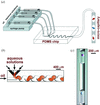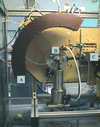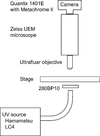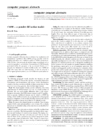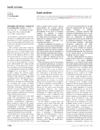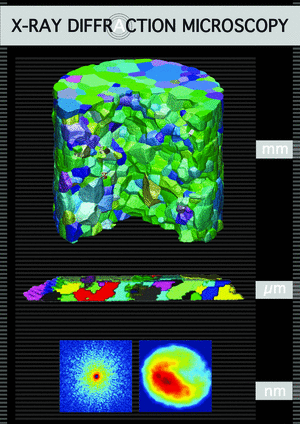issue contents
December 2005 issue

Cover illustration: Secondary electron image of a crystalline iron ore sinter phase, produced by heating to 1533 K and then cooling. Courtesy of N. V. Y. Scarlett, I. C. Madsen, M. I. Pownceby & A. N. Christensen [J. Appl. Cryst. (2004), 37, 362-368].
research papers
A new similarity index for comparison of powder diagrams is introduced. It is applied for crystal structure determination by consecutive crystal structure prediction and refinement in cases of overlapping peaks and large deviations in the cell constants.
The crystal structures of compositionally homogeneous, nanocrystalline ZrO2–CeO2 powders, synthesized by a pH-controlled nitrate–glycine gel-combustion process, were studied by synchrotron X-ray diffraction. The use of a high-intensity synchrotron source allowed distinction between the metastable forms of the tetragonal phase from the cubic phase and determination of the compositional boundary between them.
Open  access
access
 access
accessAn approach is presented in which several biophysical solution techniques, such as small-angle scattering, sedimentation velocity analytical ultracentrifugation and fluorescence resonance energy transfer, are employed to find the low-resolution structure of a macromolecular complex using generalized rigid-body modelling.
The crystalline microstructure of sepiolite ground for different times in a vibrating cup mill is characterized by prevalent crystallite shape, volume-weighted crystallite size distribution and second-order crystalline lattice strain distribution determined from X-ray diffraction patterns. These characteristics, which are dependent on grinding time, are in good agreement with those obtained via measurements of specific surface by nitrogen absorption and analysis of field emission scanning electron microscope images.
In order to decrease the time and increase the efficiency from protein crystallization hits to refined atomic models, protocols for in situ X-ray data collection from crystals grown by `microcapillary' protein crystallization techniques are being developed, through which appropriate capillary materials and fluorocarbon oils are suggested on the basis of minimizing background X-ray scattering. The methodology eliminates the need for crystal handling, cryocooling and mounting, and reduces the volume of consumed protein solution by tenfold relative to the currently available protein crystallization tools.
A new two-stage direct-methods procedure for solving crystal structures of centrosymmetrical zeolites is described that uses the powder patterns of the `as made' and `calcined' zeolites. Its viability is illustrated using the novel complex zeolite ITQ-32, containing nine Si atoms in the asymmetric unit.
The dislocation densities and crystallite size distributions in ball-milled fluorides have been determined by X-ray diffraction line-profile analysis. In some cases, an interference effect similar to that described previously has been observed and in those cases the effect has been corrected for during the evaluation procedure.
This paper outlines the use of an innovative system for the in situ investigation of hydrothermal reactions by X-ray diffraction. The in situ technique described in this paper allows the direct observation of kieserite formation during pressure acid leaching of saprolite at 493 K and its dissolution upon cooling to ambient temperature.
The dips appearing in the neutron spectrum transmitted by a mosaic crystal are used to define the crystal orientation and the mosaicity of the sample. The evolution of both parameters for a Cu monochromator loaded in tension along the [110] direction is reported.
The use of mineral oil to improve cooling rates during flash cooling by liquid nitrogen is discussed with relevance to macromolecular crystallography.
Microstructure characterization and phase transformation kinetics of a high-energy ball-milled and post-annealed stoichiometric (1:1 mol%) m-ZrO2 and amorphous (a-) SiO2 powder mixture have been investigated by Rietveld analysis of X-ray powder diffraction data.
The effects of torsions on the integrated intensity of X-rays diffracted from a silicon specimen were investigated when the specimen was set vertically under the symmetrical Laue condition and rotated around the scattering vector.
A time-of-flight Laue neutron macromolecular diffractometer (MaNDi) has been designed for the Spallation Neutron Source (SNS) that is under construction at Oak Ridge National Laboratory. Calculations and simulations predict that MaNDi can provide 10–50-fold gains in performance compared with current facilities.
Periodic transitions of microcrystal morphologies have been observed on the (110) face of laser-active KLu(WO4)2 crystals at a high supersaturation. The morphologies of the three microcrystals have a 180° rotation relationship, indicating that periodic transition occurs during the process of crystal growth.
Neutron optics measurements using converging lenses indicate the variation in the breadth of focused beams as a function of wavelength. Off-axis incidence enables a partial offset of the effects of gravity.
A method to identify and optimize protein crystallization conditions is described, in which gradual desiccation of protein-containing droplets ensures a phase transition, and the nature of the resulting solid phase is used to guide the identification of crystallization conditions. The number, quality, and size of the resulting protein crystals is shown to depend significantly on the rate of increase in protein concentration, a key variable in the method described.
Low-resolution shapes of polycarbosilane dendrimers with the three-functional and the four-functional branching centre reconstructed ab initio from small-angle scattering data reveal anisometric structures permeable to the solvent.
The design and performance of an ultra-high-resolution small-angle neutron scattering (USANS) double-crystal diffractometer is described. Particular emphasis is placed on features that both maximize beam intensity and minimize detector background.
A complex pattern of opposite and antiparallel periodic poled domains in LiNbO3 single crystals has been studied by X-ray topography. The antiparallel periodic poled domains appear in alternating crescent-shape domains where the measured Li/Nb ratio is higher.
A method is presented that allows the exact calculation of the radial distribution function for the X-ray case. Special consideration is given to nanoparticle models for which not all interatomic distances can be defined accurately.
short communications
Download citation


Download citation


The application of a new technique for zeolite framework structure solution is described that exhaustively enumerates every possible topology consistent with known unit-cell dimensions and space-group symmetry.
laboratory notes
This paper describes the relatively simple modification of a light microscope to operate with ultraviolet-based optics. Using a 280 nm UV illumination source, protein microcrystals are readily visualized in gels made from hydrated bilayers of phospholipids.
The upgrades of SANS-U at the JRR-3M research reactor of the Japan Atomic Energy Research Institute include (i) replacement of the two-dimensional area detector by a multi-wire type position-sensitive proportional counter, (ii) renewal of the operating system from a VAX and sequencers to an integrated PXI system controlled by LabVIEW-RT software, (iii) a focusing collimation system, and (iv) a variety of accessory equipment.
Open  access
access
 access
accessVariable-temperature high-resolution capillary-mode powder X-ray diffraction is used to assess changes in unit-cell dimensions as a function of temperature over the range 188–328 K.
computer program abstracts
The CMPR program is a platform-independent package of tools for visualizing and manipulating powder diffraction data.
book reviews
Free 



 journal menu
journal menu













